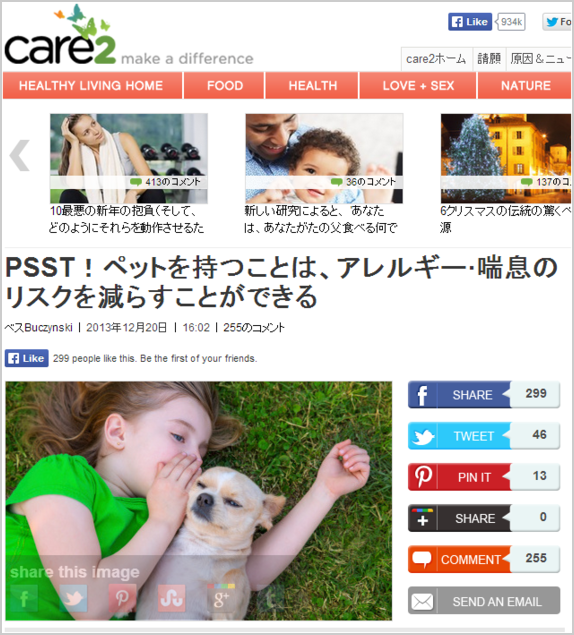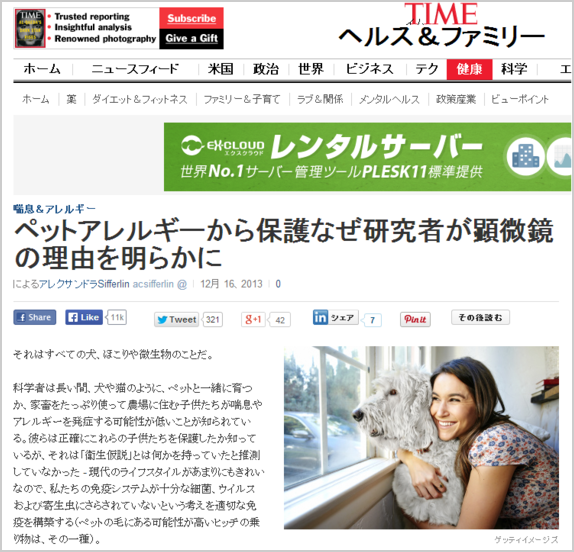Pet May Reduce
- Chlorine 塩素とアトピー性皮膚炎
- 愛犬の幸せを考えてみよう!
- 特集<愛犬の『食』を考えよう!!
-
愛犬は骨で大変な目にあったのでよくかんがえて・・・
ペットの生活
PSST!ペットを持つことは、アレルギー·喘息のリスクを減らすことができる

育って、私たちはペットを持っていなかった。 [OK]まあ、そこスナネズミとの短い試合だったが、それは実際にはカウントされません。私の妹は、特に猫に、定期的なアレルギーに苦しんでいる理由の新しい研究によると、毛皮で覆われた友人の私達の欠如が説明できる。
Growing up, we never had pets. Well OK, there was a brief bout with a gerbil, but that doesn’t really count. According to new research, our lack of furry friends could explain why my sister suffers from regular allergies, especially to cats.
ミシガン大学からの新しい調査によると、科学者たちは長い間、犬や猫のように、ペットと一緒に育つか、家畜をたっぷり使って農場に住んでいる人々は、喘息やアレルギーを発症する可能性が低いと考えています。細菌、ウイルスおよび寄生虫の特定のタイプへの曝露の欠如は、免疫系を抑制するという考え:彼らは、「衛生仮説」と呼ばれる。仮説は理にかなっているが、証明することが難しかった。今、研究者が一歩近づくのペットを持つことは、その後の人生におけるアレルギーの危険性や喘息を軽減するように見える理由を理解することである。
According to a new study from the University of Michigan, scientists have long believed that people who grow up with a pet, like a dog or cat, or live on a farm with plenty of livestock are less likely to develop asthma or allergies. They called it the “hygiene hypothesis”: the idea that lack of exposure to certain types of bacteria, viruses and parasites inhibits the immune system. The hypothesis makes sense, but was hard to prove. Now, researchers are one step closer to understanding why having a pet seems to reduce the risk of allergies and asthma later in life.
「ミシガン大学の研究者チームは、犬の所有者の自宅のゴミに対するマウスのグループを露出した後、彼らと(ゴキブリ化合物を含む) 2喘息関連アレルゲンに犬のほこりを与えられなかったマウスの人口を浴びせ「 TIME誌が報じている。 「犬の粉塵にさらされていたマウスは、気道内のはるかに低い炎症を示し、 nondog家計からのごみやほこりを受けなかったマウスよりも少ない粘液を生産した。 "
“A team of researchers from the University of Michigan exposed a group of mice to dust from a dog owner’s home, then doused them and a population of mice who weren’t given dog dust to two asthma-related allergens (including cockroach compounds),” reports TIME Magazine. “The mice that had been exposed to the dog dust showed much lower inflammation in their airways, and produced less mucus than the mice that received no dust or dust from a nondog household.”
結果は(だけでなく、おそらく他の動物)犬の塵の中に住んでいる小さな微生物の働きであると思われる。これらの微生物にさらされたときに、ラットの腸内で生きている生物は、それらがアレルゲンに対するより良好な防御機構を開発することができ、形質転換、および炎症性応答を低減した。
The results seem to be the work of tiny microbes living in the dog’s dust (and presumably other animals as well). When exposed to these microbes, the organisms living in the rats’ gut were transformed, allowing them to develop better defense mechanisms against the allergens, and reducing inflammatory response.
「具体的には、研究者は、ラクトバシラス·という単一の細菌は、犬関連のほこりと一緒に住んでいたマウスの内臓で非常に顕著であることがわかった。研究者は犬の粉塵にさらされていなかったマウスへの細菌の生きた形を与えたときに、彼らは動物が粉塵暴露されたマウスが持っていたアレルゲンに対する同様の保護を開発したことを発見し、 「 TIMEは説明しています。
“Specifically, the researchers found that a single bacteria called Lactobacillus johnsonii was very prominent in the guts of the mice who lived with dog-related dust. When the researchers gave a live form of the bacteria to the mice that had not been exposed to dog dust, they found that the animals developed similar protection against allergens that the dust-exposed mice had,” explains TIME.
科学者は、所与の時間、それらはアレルギーおよび喘息の子どもを治療または保護することができるプロバイオティクス微生物又は治療法を開発するためにこの情報を使用できるようにしてもよいと言う。誰もがペットを得た場合、私はまだそれだけでもっと楽しくなると思うけれども!
Scientists say that given time, they may be able to use this information to develop probiotics or microbe therapies that could treat or protect children from allergies and asthma. Although I still think it’d just be more fun if everyone got a pet!
も参照してください:
http://www.care2.com/greenliving/psst-having-a-pet-may-reduce-your-risk-of-allergies-asthma.html
喘息&アレルギー / Asthma & Allergies
ペットアレルギーから保護なぜ研究者が顕微鏡の理由を明らかに
Researchers Reveal the Microscopic Reasons Why Pets Protect Against Allergies

それは犬、ほこりや微生物がすべてです。
It’s all about dogs, dust and microbes.
科学者は長い間、犬や猫のように、ペットと一緒に育つか、家畜をたっぷり使って農場に住む子供たちが喘息やアレルギーを発症する可能性が低いことが知られている。彼らは正確にこれらの子供たちを保護したか知っているが、それは「衛生仮説」とは何かを持っていたと推測していなかった - 現代のライフスタイルがあまりにもきれいなので、私たちの免疫システムが十分な細菌、ウイルスおよび寄生虫にさらされていないという考えを適切な免疫を構築する(ペットの毛にある可能性が高いヒッチの乗り物は、その一種) 。
Scientists have long known that kids who grow up with a pet, like a dog or cat, or live on a farm with plenty of livestock are less likely to develop asthma or allergies. They didn’t know what exactly protected these kids, but speculated that it had something to do with the “hygiene hypothesis” — the idea that modern lifestyles are too clean and therefore our immune systems aren’t exposed to enough bacteria, viruses and parasites (the kind that likely hitch rides in pet hair) to build up proper immunity.
今、研究者は、彼らが可能性のある説明に近づいていると思います。
Now, researchers think they are getting closer to a possible explanation.
(もっと:研究:犬と猫赤ちゃんが健康になぜ)
(MORE: Study: Why Dogs and Cats Make Babies Healthier)
ミシガン大学の研究者のチームは、彼らと(ゴキブリ化合物を含む) 2喘息関連アレルゲンに犬のほこりを与えられなかったマウスの人口を浴びせた後、犬の所有者の自宅のゴミに対するマウスのグループを露呈した。犬の粉塵にさらされていたマウスは、気道にはるかに低い炎症を示し、 nondog家計からのごみやほこりを受けなかったマウスよりも少ない粘液を作り出した。
A team of researchers from the University of Michigan exposed a group of mice to dust from a dog owner’s home, then doused them and a population of mice who weren’t given dog dust to two asthma-related allergens (including cockroach compounds). The mice that had been exposed to the dog dust showed much lower inflammation in their airways, and produced less mucus than the mice that received no dust or dust from a nondog household.
しかし、それは防御的であったほこりはありませんでしたが、何がほこりに住んでいた - 実際にげっ歯類「腸内に住む生物のコミュニティーを再構築微生物を。これらの変化は、免疫マウスの応答と特定のアレルゲンを撃退する能力に影響を与えた。具体的には、研究者は、ラクトバシラス·という単一の細菌は、犬関連のほこりと一緒に住んでいたマウスの内臓で非常に顕著であることがわかった。研究者は犬の粉塵にさらされていなかったマウスへの細菌の生きた形を与えたとき、彼らは動物がゴミ曝露マウスが持っていたアレルゲンに対する同様の保護を開発したことがわかった。
But it wasn’t the dust that was protective, but what lived in the dust — microbes that actually reshape the community of living organisms in the rodents’ gut. These changes influenced the immune response of the mice and their ability to fight off certain allergens. Specifically, the researchers found that a single bacteria called Lactobacillus johnsonii was very prominent in the guts of the mice who lived with dog-related dust. When the researchers gave a live form of the bacteria to the mice that had not been exposed to dog dust, they found that the animals developed similar protection against allergens that the dust-exposed mice had.
雑誌に掲載された調査結果、約励ましているのか、全米科学アカデミー紀要には、犬に関連したホコリは子供の喘息にリンクされている微生物に対する免疫応答を促すように見えたという事実である。だから、結果は腸内細菌を操作する方法については今後の研究につながる可能性 - おそらくプロバイオティクスまたは他の微生物戦略を - アレルギーや喘息の子どもを治療または保護することができる。
What’s encouraging about the findings, which were published in the journal, Proceedings of the National Academy of Sciences, is the fact that the dust associated with the dogs seemed to prompt an immune response against microbes that have been linked to asthma in kids. So the results could lead to future studies on how manipulating gut bacteria — possibly with probiotics or other microbial strategies — could treat or protect children from allergies and asthma.
MORE :調査:ペットお問い合わせ友達が行うのと同じ暖かいFuzziesを進呈
MORE: Study: Pets Give Us the Same Warm Fuzzies That Friends Do
アレクサンドラSifferlin @ acsifferlin
アレクサンドラSifferlin時間Healthlandのライター兼プロデューサーである。彼女はジャーナリズムのノースウェスタン大学メディルスクール卒業。
Alexandra Sifferlin @acsifferlin
Alexandra Sifferlin is a writer and producer for TIME Healthland. She is a graduate from the Northwestern University Medill School of Journalism.
続きを読む:犬ダスト中の細菌が喘息やアレルギー背景に子どもを保護することができる| TIME.com
Read more: Bacteria in Dog Dust May Protect Children Against Asthma and Allergies | TIME.com http://healthland.time.com/2013/12/16/researchers-reveal-the-microscopic-reasons-why-pets-protect-against-allergies/#ixzz2oh7ZQl8G